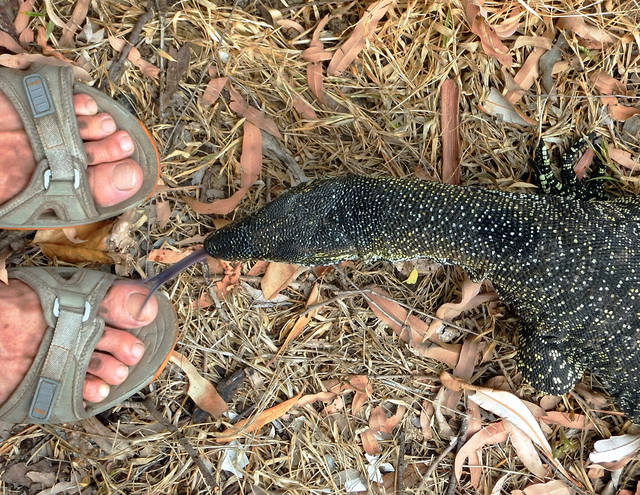Published in the Ocean Watch column, Honolulu Star-Advertiser © Susan Scott
May 6, 2017
Pancake Creek, Queensland >> Australia has a national phobia about snakes.
We started our latest Australian adventure by sailing to this national park estuary that has no access by road. At Pancake Creek the beaches are huge (one is called Aircraft Beach because small planes can land there), the wildlife abundant (soldier crabs, stone curlews, friendly monitor lizards), and the hiking possibilities are nearly endless.
 A lace monitor lizard tasting the writer’s toes at
A lace monitor lizard tasting the writer’s toes at
Aircraft Beach, Eurimbula National Park.
©2017 Susan Scott
Pancake Creek is Australian wilderness at its best, so good I feel lucky to once again be visiting this magnificent country. So what’s the first thing several locals said when I told them we were sailing here? “Watch out for snikes.” (They mean snakes.)
The Pancake Creek region has no more snakes than anywhere else in the country, but OK, I’ll give Aussies the fact that most of the world’s venomous snakes are found in Australia. Of the country’s 172 species, 115 are venomous.
Most of the world’s pythons are Australian, the longest being the scrub python at 23 feet, as long as a two-story building is tall. I have a book aboard Honu with an amazing picture of an olive python — only about 16 feet long but bulkier than a scrub python — trying to haul a drowned wallaroo up a cliff for a meal.
In the Darwin area, homeowners have to protect their dogs, chickens and cats from olive pythons that squeeze the pets until they stop breathing, and then swallow them.
During dry spells some snakes seek out water and have been found bathing in residents’ toilets. One 7-foot-long snake worked its way through an overhead light fixture in an apartment bathroom. Roommates walked in to find the snake dangling, giving them an updated version of the “Psycho” shower scene.
My favorite Australian snake story happened in 2013 when a passenger aboard a Qantas flight pointed out a snake on the wing to a flight attendant. The scrub python bravely held on for the entire hour-and-50-minute flight. People rooted for the plucky animal, but the wind and cold were too much for it,and, sadly, the hitchhiking python died.
All snakes have forked tongues that they flick in and out to taste or smell potential food. Only Australia’s goanna lizards, called monitor lizards in other countries, share this forked tongue trait with snakes. (Goanna is the Australian version of the word iguana, a group of lizards from the Americas unrelated to monitor lizards.)
So far, we’ve encountered no snakes while hiking around Pancake Creek, but I did manage to hold still in a picnic area while a goanna (lace monitor lizard) flicked its forked tongue over my toes.
In the meantime, we Americans are looking forward to meeting some Australian snikes.